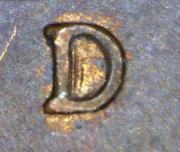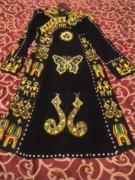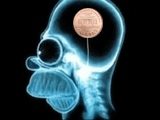I'm not sure what you mean by DD, do you mean Doubled Die (Hub Doubling) or a Double Strike? A Double Strike is easy as it is creating by two (or more) separate strikes from a die, whereas MD is created by some of the extra energy from a single strike where the Die Face bounces or vibrates up and down or in some rare cases drifts sideways.
A Doubled Die is created from the Hub, which is a positive (and looks like a struck coin), that has been misaligned in a subsequent hubbing (or moved during a single hubbing - post '97). The positive parts of the Hub stick out and create impressions (incuse) into the Die Face; in essence holes or cavities replicating the design. In the hubbing process once you create an incuse area, adding to that incuse area within the area of the fields always makes the design a little larger. You can experiment with this by making impressions of a coin in clay (or play-dough) and then turning or offset the coin and making another impression.
I hope I am answering your question...
Welcome guest, is this your first visit? Click the "Create Account" button now to join.
Results 31 to 40 of 40
Thread: Machine Doubling (MD)
-
02-06-2012 #31
Jason Cuvelier
MadDieClashes.com - ErrorVariety.com
TrailDies.com - Error-ref.com - Port.Cuvelier.org
CONECA
(images © Jason Cuvelier 2008-18)___________________
-
Post Thanks / Like - 1 Thanks, 0 Likes
 N/A thanked for this post
N/A thanked for this post
-
02-07-2012 #32EgCollectorGuest
You certainly did
 and by DD i meant Double Die as a word but Double strike as a meaning so you actually explained double strike and taught me Double Die
and by DD i meant Double Die as a word but Double strike as a meaning so you actually explained double strike and taught me Double Die 
Thank you Jason very much
-
02-07-2012 #33strwrght53Guest
excellent photos expertly illustrated can't help but learn from them...thanks
-
02-07-2012 #34
Hey Jason, being fairly new at this coin stuff it might help to explain how and what a DD (bad name) hub doubling is caused. (I may have missed the explanation in the new section.) My understanding is that DD or hub doubling is caused when making or re-stamping the die itself and has nothing to do with striking the coin. Whereas MD is caused when the coin is actually struck. What is the best way to talk about hub doubling? Does saying a DD create confusion? I know until I researched terms I was confused. Double dies has been such a standard for so long. We reference things like DDO or DDR etc.
This brings up a question is once a die goes into or back into service what is the life of the die? I guess if there is a a die that is damaged and creating a hub doubled coin how many coins would be made until it is taken out of service? I imagine there is some QC during the striking and if there is a damaged die that it would be taken out of service in short order. Hence making that damaged coin that much more valuable. I guess the question would be is do you know how many coins that would be struck before the die is taken out of service for repairs or out of service permanently? I mean just a guess. There must be a ton of reasons for a die to be taken out of service before is normal use life. I guess I am just wondering if there is like 1000 coins struck to 50,000 coins struck or??? I hope I understand some of this stuff anyway and it all makes some sense.
I hope I understand some of this stuff anyway and it all makes some sense.
-
12-10-2012 #35Seeker7Guest
Fantastic pics! I am starting to learn the difference between DD and MDD. I want to thank you for the time and effort you went through to set these examples up.
-
Post Thanks / Like - 1 Thanks, 0 Likes
 jcuve thanked for this post
jcuve thanked for this post
-
12-10-2012 #36Seeker7Guest
I enjoyed the tutorial! Thank you for helping us rookies get it straight.
-
12-10-2012 #37
-
Post Thanks / Like - 1 Thanks, 0 Likes
 jcuve thanked for this post
jcuve thanked for this post
-
05-01-2013 #38Drav3nGuest
This was a great tutorial mate! Thank you so much. I, being a newer collector was looking just for this type of information. Coupled with a few other tutorials that I have read I believe that I will be well on my way to building a decent collection. Thanks again!
-
09-21-2013 #39
Great tutorial and great pics! Thanks
-
05-18-2014 #40
Thanks for the awesome thred, your very talented teacher. Plus the knowledge gained, I now have the perfect point of reference!

-
Post Thanks / Like - 1 Thanks, 0 Likes
 rickybailey50 thanked for this post
rickybailey50 thanked for this post









 Reply With Quote
Reply With Quote


Bookmarks